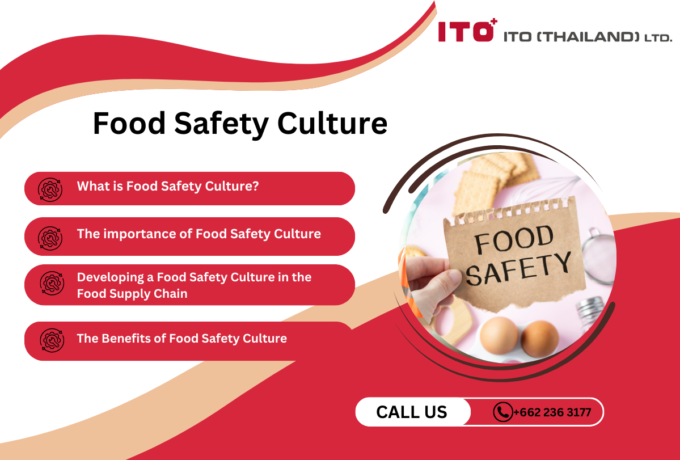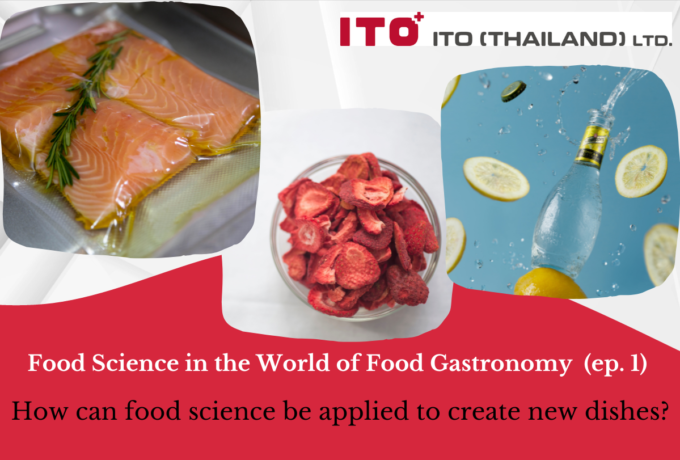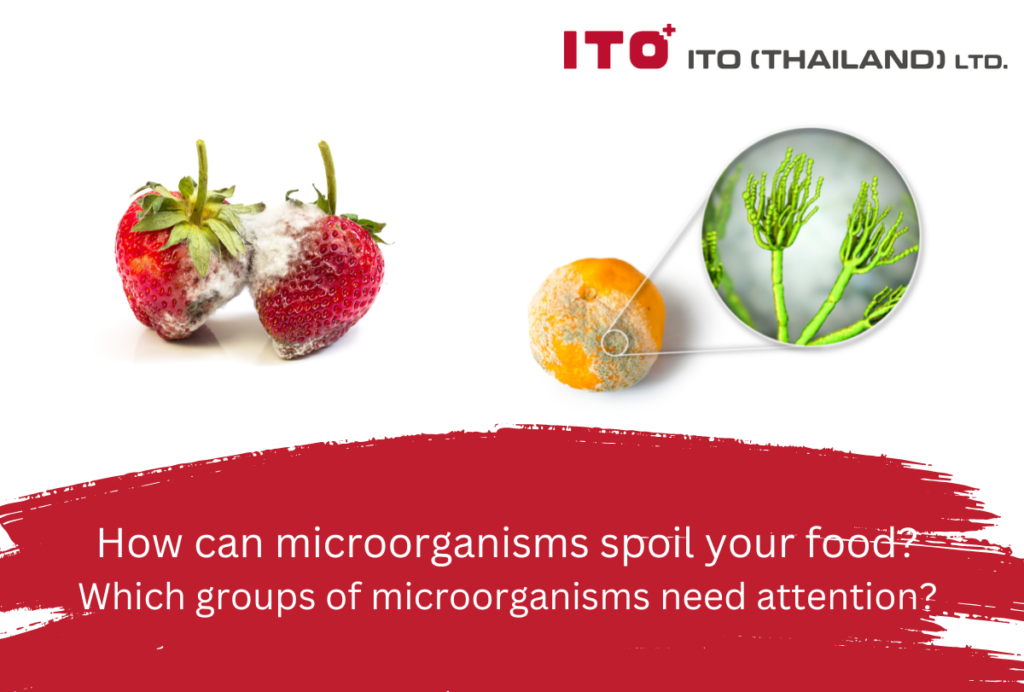ITO Thailand Hygiene Blog
Specific Spoilage Organisms (SSOs)
Food spoilage from microorganisms, whether bacteria, fungi, viruses, or other microorganisms, can be divided into 2 types: expired due to safety, i.e., the growth of disease-causing pathogens such as food poisoning, or microorganisms producing toxins harmful to the body and expiring due to food deterioration such as changes of color and texture, off flavour, loss of vitamins until less than stated on the label, etc. Although the food is still safe to consume, and it does not cause disease or abnormalities when eaten, consumers can no longer accept or are not satisfied with it (read more: Factors Affecting Shelf Life of Foods, Determining the Shelf Life of Foods). These quality deteriorations may be caused by microorganisms such as acid-producing bacteria resulting in unpleasantly sour taste, pigment-producing fungi that discolor food, or in the case where microorganisms grow and produce various substances causing the properties of food to change, such as enzymes, volatile substances with odor, etc. Each type of food will have different microorganisms, depending on the conditions of the food are suitable for the growth of which type of microorganisms, such as microorganisms that are acid resistant, salt resistant, heat resistant, cold resistant, resistant to anaerobic conditions, resistant to dehydration, etc., including food components such as carbohydrates, proteins, fats, which are food sources for different microorganisms as well.
What microorganisms spoil which food? (1)
•Meat
Deterioration of meat occurs when an animal dies, shutting down enzymes and the immune system, leading to external contamination such as dirt on surfaces, excrement, butchering equipment and contamination from workers’ hands. Contaminant microorganisms thrive on meat because blood and protein are a rich source of food. Microbial spoilage of meat is as follows:
Souring: Lactobacillus, Leuconostoc, Alcaligenes, Pseudomonas spp.
Discoloration) such as red spots, blue, yellow: Serratia marcescens, Pseudomonas syncyanea, Micrococcus, Flavobacterium spp.
Slime: Micrococcus spp., Lactobacillus, Bacillus, Leuconostoc spp.
Putrefaction: Clostridium, Alcaligenes spp.
Bone taint: Clostridium spp.
Spongy texture: Bacillus spp.
•Milk and dairy products
Microbial contamination that spoils milk and dairy products can be from the udders of animals that are inflamed, sick or from unhygienic milking processes. Common spoilage characteristics and related microorganisms are as follows:
Souring: Lactobacillus spp., Micrococcus, Bacillus cereus
Off-flavor: Pseudomonas spp., Staphylococcus spp.
Bitter: Pseudomonas, Flavobacterium, Bacillus spp.
Discoloration: Pseudomonas syncyanea with L. lactis, Lactobacillus, Leuconostoc spp.
Ropiness: Micrococcus spp., Alcaligenes viscolactis
Rancidity: Micrococcus, Serratia, Pseudomonas spp.
Sweet curdling: Alcaligenes, Proteus spp.
•Vegetables and Fruits
Vegetables and Fruits are sources of carbohydrates, especially sugar, microorganisms, vitamins, and minerals, including high humidity, which is necessary for the growth of microorganisms. Each type of fruits has different microbial spoilage due to factors such as acidity, carbohydrate accumulation in tuber crops, moisture content, the likelihood of ground contact (e.g., underground roots or stems or shoots or fruits on plants), nature and structural composition, etc.
Souring: From lactic acid-producing bacteria such as: Lactobacillus spp.
Soft rot: Usually found in tubers or underground roots such as potatoes) from bacteria that digest pectin structures to soften the structure such as Erwinia spp. Pseudomonas marginalis, Bacillus, Clostridium spp.
Off flavor: Acidic fruit juices by microorganisms that can tolerate acids such as Alicyclobacillus spp.
Fermented odor: From yeast
Surface mold (2): from mold species of Penicillium, Aspergillus, Rhizopus, Alternaria, and Fusarium spp.
•Grains and bakery products
As this group of products has low moisture content, they are less likely to be spoiled by microorganisms, but rather by mold. However, in the bakery food production process, moisture is often added and there is fermentation or resting the dough, which may cause the growth of Leuconostoc and Lactobacillus spp. microorganisms that cause spoilage. For baked products that are slowly cooled in high humidity conditions, B. subtilis microorganisms may grow and cause abnormal odor and ropiness in the products.
Reference
1.Robinson, R. K. (2014). Encyclopedia of food microbiology. Academic press.
2.Lasztity R. 2009. Food Quality And Standards – Volume III. EOLSS Publications
Related Post
-

Food Safety Culture
Food safety culture plays a crucial role in safeguarding the company's reputation, ensuring the well-being of its employees, and providing a safe experience for its customers.
-

New food source safety issues
What are safety issues worth knowing for trendy new food sources like plant-based and insect-based proteins?
-

British Retail Consortium (BRC) Standard
Food safety management systems play a vital role in ensuring the production and distribution of safe and high-quality food products to consumers. With the global food supply chain becoming increasingly complex, food businesses must implement effective systems prioritising safety, quality, and compliance with industry standards. A food safety management system encompasses a set of procedures, processes, and controls designed to identify, prevent, and manage potential hazards at every stage of the food production and supply process. This proactive approach not only safeguards consumers' health but also protects the reputation and credibility of food companies in an ever more competitive market.
-

Food Science in the World of Food Gastronomy (Part 1)
How can food science be applied to create new dishes?
-

FSSC 22000
Food manufacturers must ensure food safety standards and processes. FSSC 22000 is an official certification program for Food Safety Management Systems (FSMS) recognised by the Global Food Safety Initiative (GFSI). This certification scheme offers a set of guidelines and procedures to ensure uniformity, openness, and safety across your entire supply chain. It applies to all companies operating within the food and beverage industry, ranging from farmers to retailers. By fulfilling the necessary criteria and obtaining FSSC 22000 certification, it is demonstrated that the required standards for food quality and implementing effective processes to manage and mitigate risks associated with food fraud, foodborne illnesses, expensive recalls, and other external threats are met.
-

Food Safety Aspects of Artificial Sweeteners
Artificial sweeteners, also known as sugar substitutes, non-nutritive sweeteners, or high-intensity sweeteners, are artificially produced compounds utilised in place of sucrose (table sugar) to add sweetness to food and drinks. Due to their significantly higher sweetness than regular sugar, only a fraction of artificial sweeteners (200 to 20,000 times less) is required to achieve an equivalent level of sweetness. Since the caloric contribution of these sweeteners, when used in such small quantities, is insignificant, they are often referred to as non-nutritive (4).










